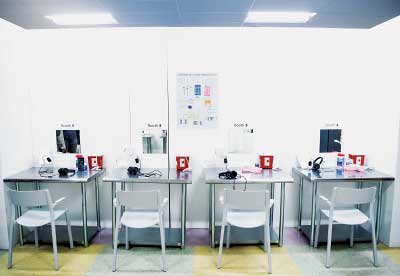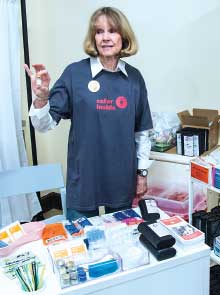Justice Dept. Threatens Action Against Planned Safe Injection Sites
Abstract
As cities and states grapple with the rising opioid overdose death toll, they meet resistance from the Department of Justice over planned safe injection sites.
The U.S. Justice Department last month threatened “swift and aggressive action” against cities or counties that open safe injection sites for drug users.

This is a mock-up of a safe injection site at Glide Memorial Church in San Francisco. Health care workers with naloxone would monitor injections by viewing clients via mirrors while other workers would provide clean syringes.
Much like needle exchange programs, the goal of safe injection sites is to reduce the risk of harm—infection, disease transmission, and overdose—while allowing counselors to persuade users to enter recovery or harm-reduction programs. Such sites are viewed as a stopgap measure to help curb opioid overdose deaths. More than 72,000 Americans died of overdose in 2017, a 10 percent increase over 2016.
A number of major cities, such as New York, Philadelphia, San Francisco, and Seattle, have announced plans to open safe injection sites, and Colorado, Maine, Massachusetts, and Vermont are among states exploring the option. But Rod J. Rosenstein, deputy attorney general of the United States, called injection sites “illegal” last month and said that maintaining one would constitute a federal felony.
At safe injection sites, substance users would bring their own drugs. Staff would provide clean needles and supervision and be quipped to administer oxygen and the overdose-reversal medication naloxone. The proposed centers are modeled after those operating in Australia, Canada, and several European countries, such as Switzerland.
The Trump administration declared the opioid epidemic a public health emergency, but despite bipartisan support for a robust plan, has focused on enhancing law enforcement and calling for longer prison sentences for drug traffickers. In an opinion piece for the New York Times, Rosenstein wrote that safe injection sites create serious public safety risks, destroy the surrounding community, and “normalize drug use and facilitate addiction.” Substance users “do not need a taxpayer-sponsored haven to shoot up,” he added.
“It is a federal felony to maintain any location for the purpose of facilitating illicit drug use,” Rosenstein wrote. “Violations are punishable by up to 20 years in prison, hefty fines, and forfeiture of the property used in the criminal activity. ... Because federal law clearly prohibits injection sites, cities and counties should expect the Department of Justice to meet the opening of any injection site with swift and aggressive action.”
Early evidence surrounding safe injection sites in practice, including one that is now operated in secret in New York City, suggests the model is effective at preventing overdoses and reducing drug-related crime, said Elie G. Aoun, M.D., an addiction and forensic psychiatrist and forensic psychiatry research fellow at Columbia University. “We have an opioid epidemic that is not being managed aggressively enough. More people are dying of overdoses than of car accidents. The safe injection sites can bring in people who historically are not interested in treatment or in quitting and bring them into contact with social workers who are trying to engage them every day.”

Linda Mantel, a harm reduction volunteer at a mock safe injection site at Glide Church in San Francisco, holds a vial of the opioid overdose reversal drug naloxone and displays the contents of “harm reduction kits” that clients would receive.
Aoun likened the opposition to safe injection sites to that by some state and local governments to needle exchange programs during the height of the HIV epidemic. “Governments that tried to prevent those harm reduction methods ended up with much higher HIV infection rates,” he said. Now, needle exchange programs operate in 38 states and have slashed HIV transmission rates by one-third to two-fifths, according to the National Institutes of Health; however, federal law forbids use of federal funds to support such programs.
The California state Assembly and Senate passed legislation in August allowing San Francisco to operate safe injection sites and grant legal immunity to the individuals who use them, but Gov. Jerry Brown vetoed the bill on September 30.
Glide Memorial Church in San Francisco’s Tenderloin neighborhood recently staged a mock demonstration showing how a safe injection site might operate: first-time “clients” would be asked to register with their first names only but would be free to use aliases. Then they would be given a “harm reduction kit” with clean syringes, antiseptic wipes, cotton balls, tourniquets, and a “cooker,” used to prepare drugs for injection. Staff would observe the injection and check for infection—from a distance—by watching from mirrors affixed to the wall near each table.
The program would dovetail with other health services that the church has long offered to the city’s low-income residents, including street outreach, syringe disposal, recovery and harm reduction programs, meals, hot showers, and referrals to mental health and medical care. “We held this demonstration to let people see how easy it would be to implement a safe injection site,” said Paul Harkin, a harm reduction program manager at Glide. The church must now await some kind of ruling or legal go-ahead before opening its doors to clients, he added.
Of course, safe injection sites are not the ultimate solution to the opioid epidemic, Aoun said, and substance users need access to medication-assisted treatment (MAT) and recovery services.
“This is a short-term fix. This is what we can do right now, today, to prevent people from dying from an overdose. Until we come up with a strategy to get people into treatment, we need to do something right now to save people’s lives.” ■



